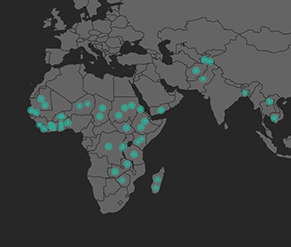With abundant natural resources and a thriving mining sector, the Democratic Republic of Congo (DRC) is showing promising economic growth. Nevertheless, the country remains one of the poorest in the world: according to the most recent World Bank estimates the extreme poverty rate in DRC was at 73% in 2018, one of the highest in sub-Saharan Africa. The combination of high poverty and inequity hinders access to education, especially for girls.
Focusing on reducing the barriers to girls’ education, GPE is supporting the Government of the Democratic Republic of Congo to ensure more girls enroll – and stay - in primary school.

Barriers to girls' education - which include early marriage, teenage pregnancies, and expectations of girls’ roles in the household, to name a few - underpin these low levels of female participation.
All of these factors are further compounded by a lack of sensitivity to gender issues and a proper system to address sexual abuse and unwanted pregnancies - which in many instances further limit girls’ participation in school.
Tackling girls’ education barriers
The US$100 million GPE grant to DRC for 2013-2017 aimed to address gender inequality in two provinces: Kasai West and Equateur.
With a focus on reducing the barriers to girls' education, the program supported the development of a girls’ education strategy and accompanying action plans, in consultation with other development partners. The strong collaboration between central and provincial departments and services enhanced the impact of these action plans.
The strategy aimed to harmonize the interventions supported by various stakeholders to accelerate progress towards gender equality in education, while contributing to the country's constitutional commitment to eliminate all forms of gender-based discrimination.
Additionally, the program supported the construction of 141 separate latrines and 23 water points in schools.
Result: More girls in school
Furthermore, 31,000 more girls in Equateur and 51,000 more girls in Kasai West enrolled in grade 1. Access to education has also improved across all schools supported by the program allowing nearly 1.5 million girls and boys to learn in a better school environment.
Building on the success of this program, the second US$100 million grant allocated to DRC for 2017-2021 aims to continue efforts to increase girls’ enrollment and retention in school.
GPE has supported the revision of the reading-writing textbooks for grades 1-3 to eliminate sexist references and stereotypes. Furthermore, GPE supported a workshop on the promotion of a girls' education strategy and the child protection law on the criminalization of early marriage in two provinces. Following the workshop, action plans were developed and submitted to the governors.
GPE also backed a public awareness campaign promoting girls' education, through the production and printing of communication materials.
Going forward, the program will focus on funding activities to prevent gender-based violence (GBV). These will include the development and implementation of training modules on GBV prevention for teachers and other actors; the development, agreement, and signing of codes of conduct for teachers; and the establishment of a grievance redress mechanism for GBV.
